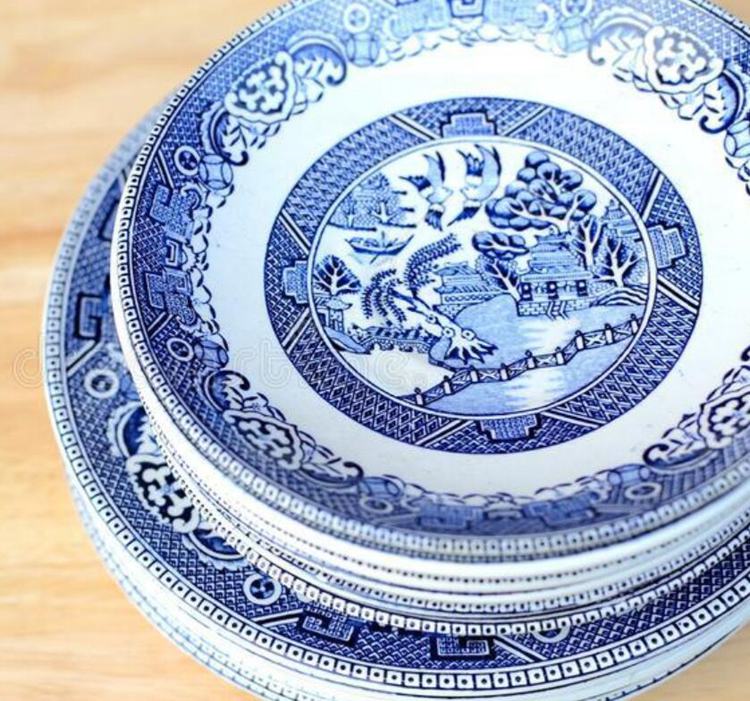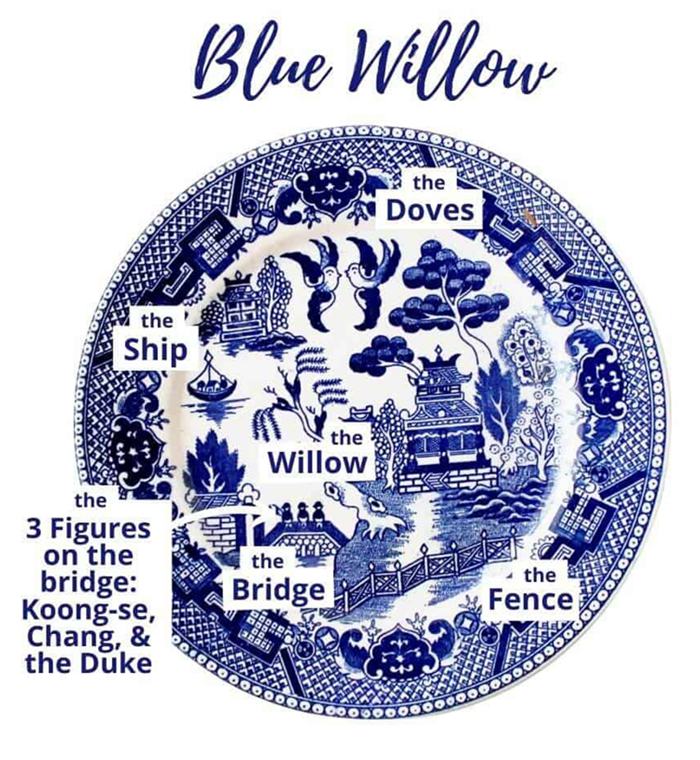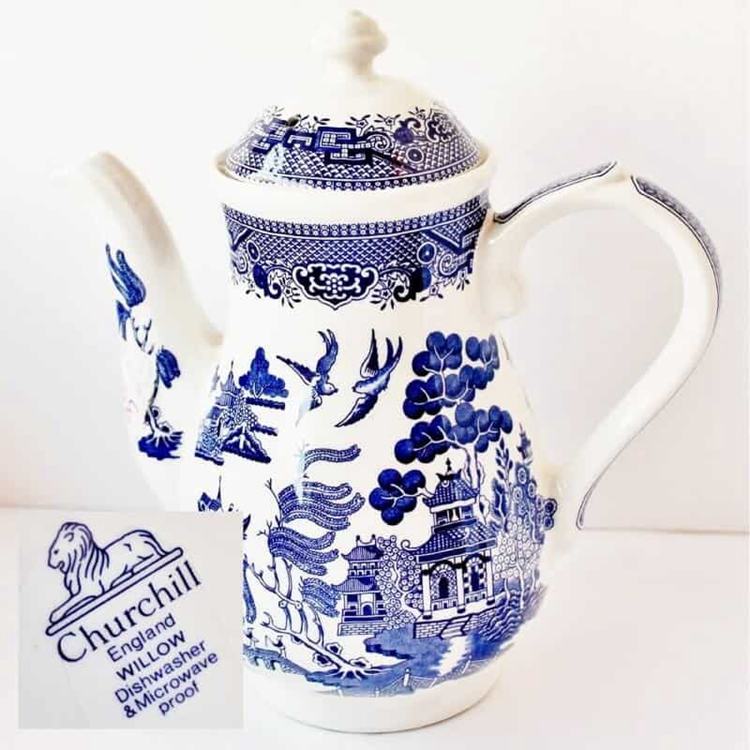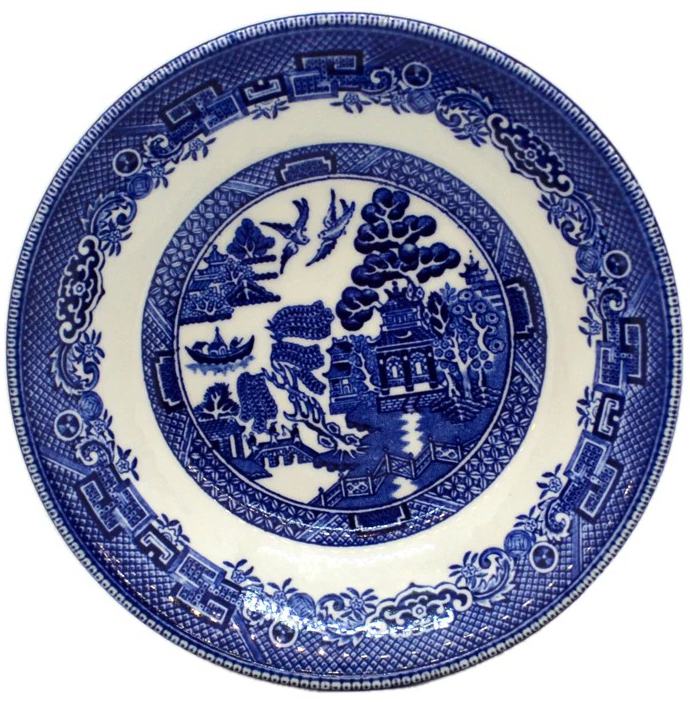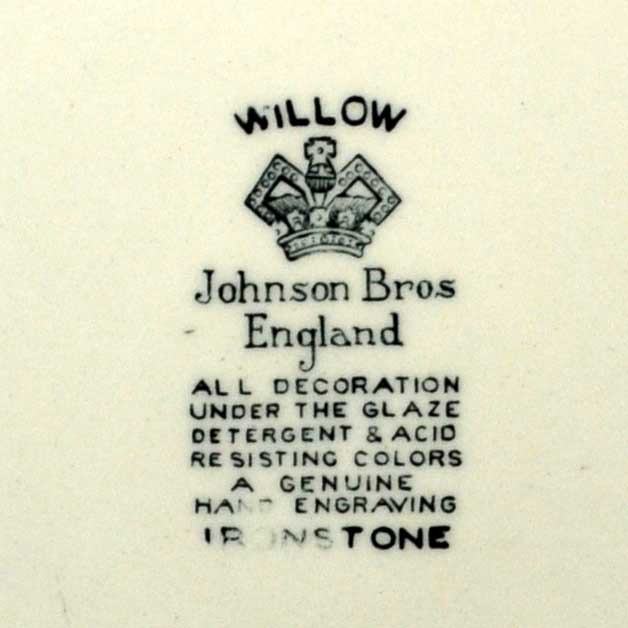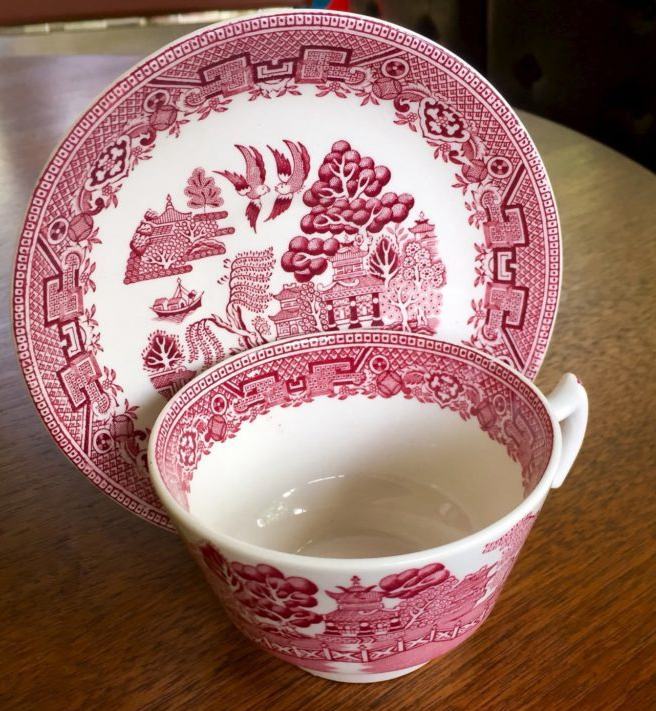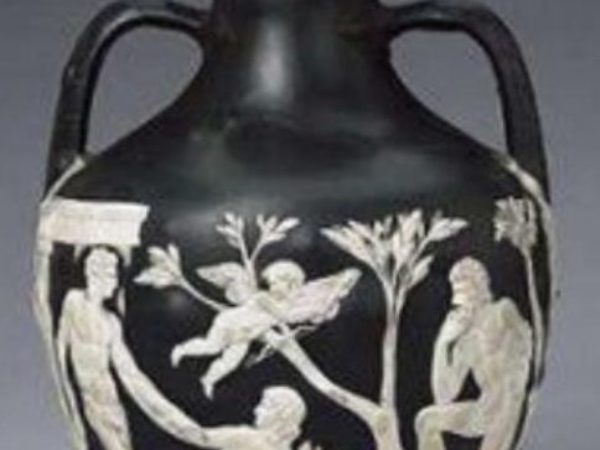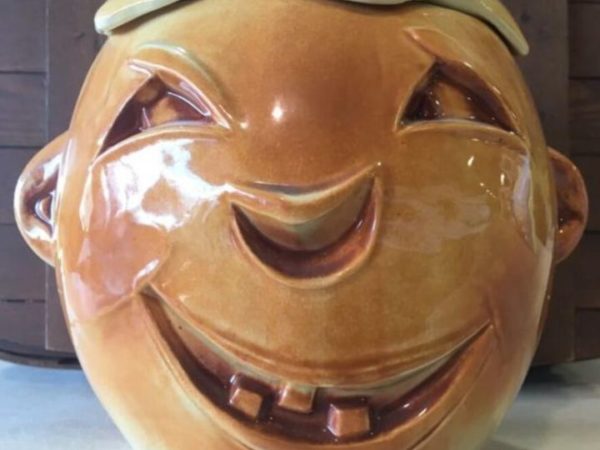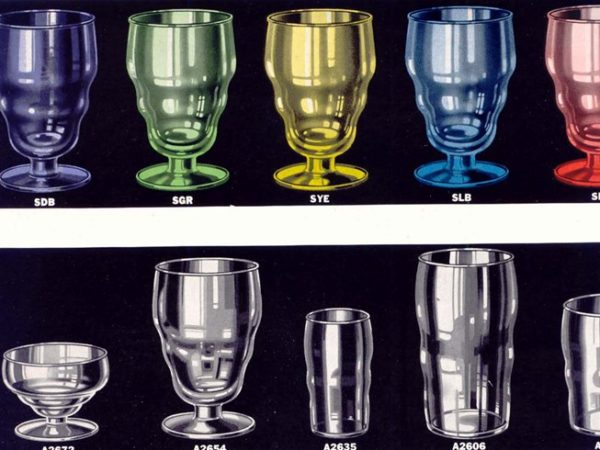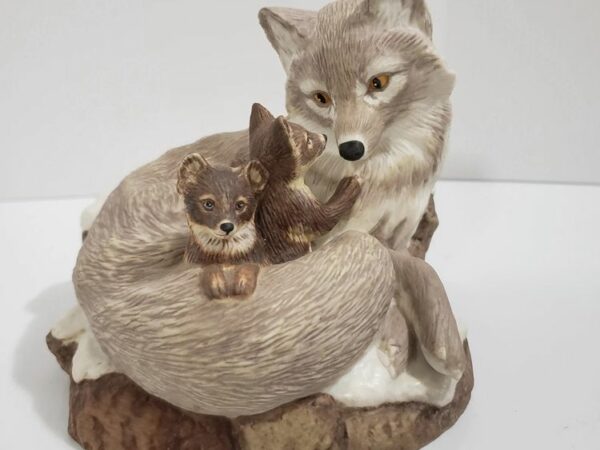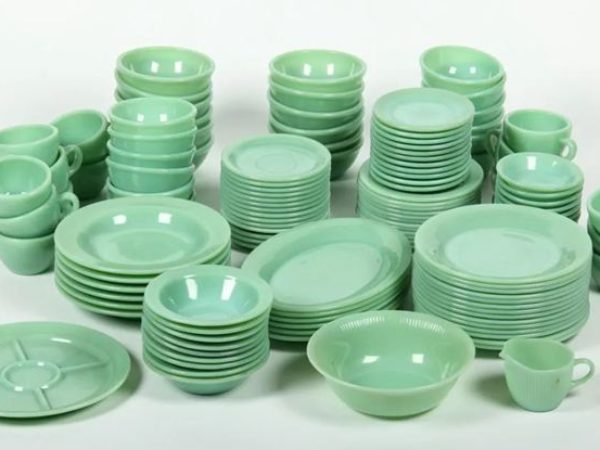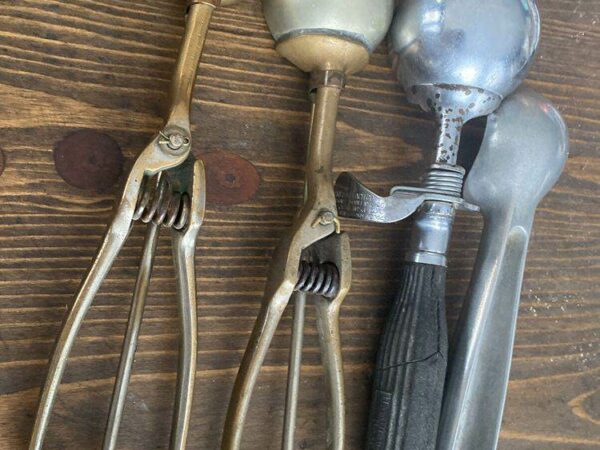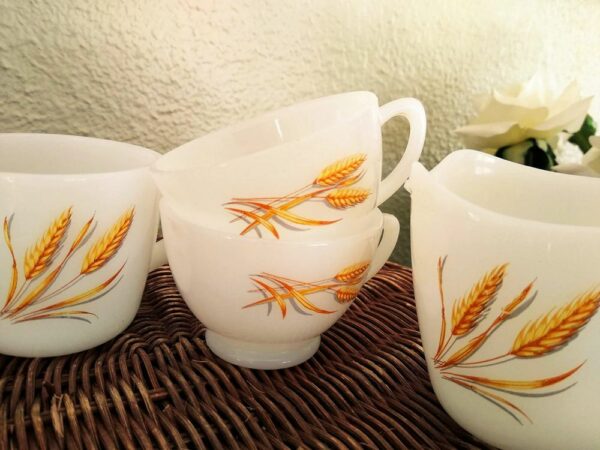Towards the end of the 16 century, the trade between the Asians and the Europeans flourished. As this happened, each of these trade partners fell in love with the native goods of their counterparts. One of their biggest interests for the Europeans is hand-painted china.
This hand-painted ceramic kitchenware drew the interest of many people with its elaborate patterns and uniqueness. As such, many English potters decided to learn from the Asians to mass-produce this kitchenware. Along with a long list of failures came some resounding successes, one of which is the Blue Willow China.
Blue Willow China, which depicts an elaborate Chinoiserie pattern, is a successful combination of English pottery and Asian motifs. Besides their seemingly mythological origins, many collectors value vintage Blue Willow China and actively search for them. This guide will benefit you If you desire to become a collector or wish to appraise your Blue Willow China.
Table of Contents
History of Blue Willow China
Blue Willow China was the creation of English potter Thomas Turner, who sent it into the market in 1779. Although the designs and patterns of this porcelain china seem Asian in origin, it’s English. Of course, the patterns were all influenced by the hand-painted Asian china, which was popular at the time.
Thomas Turner allegedly created the patterns for this china with the aid of his helpers, Thomas Lucas and Thomas Minton. Thomas Minton worked as an engraver, while Thomas Lucas was also a potter. The origin of the blue willow pattern began when these engravers were working with Caughley Salopian China Manufactory.
During this period, they studied the patterns of imported Chinese ceramics and produced landscapes based on the Chinoiserie patterns. They found out that a typical Chinese ceramic usually featured pavilions, boats, birds, and willows. Hence, they incorporated all of these into their designs, which they later used for the Blue Willow China.
After working with Caughley for some time, Thomas Lucas and Thomas Minton resigned from the company. Minton left in 1785 to open his pottery in Stoke-on-Trent, where he worked in producing earthenware. He later started to produce his own Blue Willow China, though, but that was after it surged in popularity.
Lucas, on the other hand, left Caughley to work under Josiah Spode in the Spode pottery. When Thomas Turner was leaving Caughley, he also left with his printer, James Richard. Josiah owned the Spode pottery, which also manufactured Chinese-inspired porcelain works.
Although the exact date for the blue willow china’s creation is unknown, its earliest versions incorporate some Spode pottery designs. As such, many people believe that Thomas Lucas created it in the 1790s while working for Josiah Spode. Of course, the Spode pottery designs are only seen in the earliest versions of Blue Willow china.
How Was Blue Willow China Manufactured?
Although the Blue Willow China was popular and mass-produced in Europe, its manufacturing process wasn’t easy. It required a lot of criteria and requirements to be in place, such as the usage of spotless white china. After the potter creates the design of the blue willow pattern, they have to engrave it on a copper plate.
The copper plate is then heated up, with ink being applied while it’s hot. However, this is not a one-time process, as the ink is applied and scraped off repeatedly to make it perfect. After which, a piece of paper is applied to the copper plate to transfer the design.
This piece of paper is then put into a press and modified to fit cups, plates, jugs, etc. The transfer is placed on pottery and then ground with a pestle and soft soap to apply the design. The grounding process is done by hand and requires thousands of artisans working together.
Here, the design of Blue Willow China varied, as many manufacturers added more patterns to their designs. Some manufacturers also decided to use more cobalt to create the flow blue look, making it similar to Chinese ceramics.
One of the main determinants of Blue Willow China’s value also began during its manufacturing process. This is because the ones that were created with more precision and care were quite scarce, making them more valuable. The production of Blue Willow China continued from the 18th century to the 19th and 20th centuries.
However, everything changed when war came into the picture. They had to shut the pottery factories down while the potters and engravers were sent to war. Cobalt, which was useful for the war effort, became scarce in the market since the army was monopolizing its usage.
After the end of the war, many pottery factories went out of business, and many skilled potters were also lost. This increased the manufacturing costs and caused many of the blue willow orders to be sent abroad for production. Because of these circumstances, you get Blue Willow China, that’s made in Japan.
Identification of Blue Willow China Markings
Blue Willow China had more than 400 registered potteries manufacturing it at the peak of its popularity. Of course, many unregistered factories produced some knock-offs at the time. All of this culminated in the fact that this porcelain product had varying designs, which were peculiar to its manufacturer.
However, all these china contain some core markings and characteristics that identify them as a genuine blue willow products. Any porcelain china that doesn’t contain these identifying blue willow china markings isn’t a genuine product. These Blue Willow China identification markings include:
- Two birds that are in flight
- Three figures on a bridge
- A pagoda
- A latticework fence
- A boat or a ship
- Willow trees
- Chinese pine trees
Blue Willow China markings, culled from Adirondack Girl @ Heart
All these identifying characteristics are from the Blue Willow China legend. Like most others in history, this legend is fake and was developed to boost Thomas Minton’s sales in this china. The legend was based on ‘The Green Willow,’ a popular Japanese fairy tale, and also incorporates other Asian fairy tales.
Legend of the Blue Willow
In this legend, there lived a rich Mandarin (a wealthy duke) who had a daughter, Koong-se. This wealthy duke had an assistant, Chang, who was assisting him with his accounting. The duke’s daughter fell in love with the humble accounting assistant, Chang.
However, such love was never meant to be since they were both of different statuses. The revelation of this feeling angered the duke to the point that he dismissed the accountant from his job. He also made more plans to keep these lovers apart as he built a fence around the house.
While he did this, the duke arranged for his daughter to marry another duke. That duke sailed in on a boat to take his new bride, bringing a jewelry box as a gift. They planned the arranged marriage for that day on which the blossoms fall from the willow tree.
However, that young Chang never gave up on Koong-se, and he entered the duke’s house on the wedding eve. Disguised as a servant, Chang rescued his lover, and they both escaped with the jewelry box. The duke was furious when he learned of this, and he pursued them with a whip over a bridge.
The lovers eventually escaped the duke’s capture and sailed away on one of the duke’s ships. They stopped at an island, where they lived in happiness for many years. However, this happiness wasn’t going to last for long.
The duke eventually learned of their location and sent his soldiers after them. With his permission, the soldiers captured the eloped lovers and put Chang to death. The death of her lover caused Koong-se to lose interest in leaving; as such, she later died of grief.
The gods saw the plight of these lovers and pitied them. They transformed the lovers into a pair of doves so that they could fly away and be together once again.
How to Identify Genuine Blue Willow China
Although Blue Willow China had various manufacturers, many of whom altered the blue willow pattern, knock-offs were still present. These knock-offs were poor-quality products, which undermined the authenticity of genuine rare blue willow china.
With so many genuine patterns available, utilizing only the identifying blue willow china markings makes it impossible to spot fakes. As such, there are other factors that you can consider to ascertain the authenticity of your china. You can also use these methods to help determine your blue willow china value, and they include:
Transferware Patterns
Just as was explained above, Blue Willow China is the result of transferring a blue willow pattern to china. As such, the blue willow itself is a transferware pattern placed on various pieces of china.
This process isn’t perfect like most transferware patterns, so you’ll probably see some imperfect sections. This includes areas where the motifs don’t join properly or where the transfer pattern is a little crinkled. So, there are chances that authentic blue willow china would have some imperfect transferware patterns.
Determine the Date of the Blue Willow China
Professional blue willow collectors proposed a few methods that can clue you into the date of your piece. These methods help you determine if you’re looking at rare blue willow china or a modern recreation, and they include:
- The Buffalo Pottery Company issued the blue willow pattern after 1905. As such, it was after that period that American potteries started producing blue willow pieces. So, if you see a piece that’s marked by American potteries, you can infer that it was produced after 1905.
- The production process of the pioneer blue willow pieces caused them to have a lighter glaze. After such a long period, these pieces are expected to have shown signs of cracking along their glaze. So, seeing such signs on a blue willow piece would tell you that it was probably an early piece.
- Marked blue willow china pieces offer a general idea about their age. This is because the companies that produced them only did so for a short period.
- Unmarked blue willow china is usually a modern production, or they can also say ‘made in China.
Popular Manufacturers of Blue Willow China
Popular manufacturers of blue willow china have always left their mark on the product. This made it easier for their products to be recognized, and some of these popular manufacturers include:
Churchill England Blue Willow China
Vintage Churchill England jug with identifying markings underneath culled from Adirondack Girl @ Heart.
A Churchill England mug with identifying markings under it culled from Adirondack Girl @ Heart.
Churchill China is one of the many companies that started manufacturing their blue willow china when its popularity surged. This England-based company began its production in 1795. As such, products marked with their name were produced from 1795 well into the 1800s.
A Churchill England blue willow is known for using copper engraved printing, one of the oldest printing methods. This process was so complex that a skilled craftsman could require six months just to engrave one plate. Hence, vintage Churchill blue willow china’s value is very high, with a teapot going for close to $900.
The earthenware used for this process is also durable, allowing it to withstand various kitchen accidents. An underglaze printing is also applied to the bottom of such kitchenware to make them scratch resistant. This meticulous process caused Churchill England’s blue willow china’s value to be higher than most contemporaries.
Buffalo Pottery Blue Willow China
Buffalo Pottery is an American company, and they are the first American company to produce blue willow china. Their capability in blue willow printing is so high that they matched the English in its mastery.
Buffalo Pottery china, produced in 1949, culled from Adirondack Girl @ Heart.
Buffalo Pottery products can be identified by their name written underneath them. Underneath their name is a set of codes that indicate the year and month of production. You can identify them using the information from Restaurant Ware Collectors Network; accordingly, the one above was made in 1949.
Blue Willow China Made in Japan
Made in Japan, blue willow teapot and saucer, called from Adirondack Girl @ Heart
Made in Japan, blue willow china, culled from Adirondack Girl @ Heart
Since the end of the war, many blue willow orders were exported to China. While many of them were produced as they should, others had alterations made to them. This is where most ‘Made in Japan’ pieces are made from.
Johnson Brothers Blue Willow China
Johnson Brothers china culled from Vintage Farmhouse Antiques.
The Johnson Brother is a pottery company that is based in England. Their dishware was produced in England until the Wedgewood Group purchased the company in 2003. When the Wedgewood Group purchased this company, they produced their earthenware in China, as they believed that it reduced costs.
Engraving under Johnson Brothers china culled from Vintage Farmhouse Antiques.
However, most antique Johnson Brothers blue willow china would indicate their country and date of production under it.
Important Things to Note about Blue Willow China
If you have decided to collect blue willow china, there are some important things to note about them:
They’re Not All Blue
Pink Coloured blue willow china, culled from Simplemost.
Although the name is Blue Willow China, not all pieces of this product are blue in color. Sure, the pioneer and classic versions are all cast in blue; later ones are multicolored. So, you’ll probably see pink china with the blue willow pattern, green, etc.
Brand New Blue Willow China Is Available
Although the blue willow pattern is probably ancient by now, many people still love it. As such, many of the companies that are involved in the antique versions still make new ones. So, you’ll still see the new Johnson Brothers blue willow china, Buffalo Pottery china, Churchill China, etc.
Of course, the antique versions are still worth more. However, the newer versions are more visually appealing since they’re made with high-tech machinery.
Blue Willow China Has a Dedicated Following
International Willow Collectors is an organization that was formed to bring people of equal interests together – collectors of blue willow. This organization is made of people who are well versed in blue willow pottery. So, it’s best to join them if you want to go full-time to collect such pottery pieces.
How Much Is Blue Willow China Worth
Blue Willow China is worth a lot of money as a piece of porcelain art and dinnerware. However, the blue willow china value is higher when the piece is undamaged and in mint condition.
Most people are willing to pay more if it’s antique English blue willow, which was made in the 1800s. Unmarked blue willow china, American pieces, and the Japanese-made versions are not worth much since they’re mass-produced. Hence, a good Churchill blue willow (an English piece) can be worth up to $1000.
Kitchenware like coffee pots and platters are worth more than items like coffee cups. This is because the former is unique and hard to find compared to the latter. As such, rare pieces like coffee pots can go for $650, while easily found coffee cup sets go for $30.
You’ll also spend more if you’re looking for a complete set of kitchenware. This includes a coffee pot, coffee cup, and platter from the same manufacturer and the same year of production.
Some recent Blue Willow China that was sold on eBay in 2022 include:
- An unmarked antique gilded blue willow teapot and traysold for $419.19
- An extra-large china blue and white platterwith knife scratches on its surface sold for $225
- A royal china dinner serving setwith minor wear and tear sold for $275
How to Determine Your Blue Willow China’s Value
Do you have some antique blue willow china that you want to get off your hands? Or do you have a blue willow family heirloom that you would like to know its value? Well, there are many ways to determine the value of your blue willow china, and they include:
Getting Them Appraised
The best method of knowing how much your blue willow piece is worth is having a professional take a look. Blue Willow china has a lot of pieces from a lot of manufacturers, which leads to a lot of variations. Going through these to determine its value is cumbersome and could be handled by a professional appraiser to avoid errors.
Identifying Marks
Some blue willow pieces are worth more than others, and that’s a fact. It was established above that English pieces are worth the most, followed by the American pieces.
Hence, if you want to know how much your blue willow piece is worth, you can look for identifying marks. This will tell you if a piece is English, American, Japanese, or unmarked, cluing you on how much it’s worth.
Recent Sales of Similar Pieces
You can determine the value of your blue willow china by checking up on how much its contemporaries were sold. If you go to websites like eBay, you can check their completed sale section for this. This would tell you how much other individuals would value your piece.
The Condition of the Blue Willow Piece
Mint and unused blue willow pieces are always valued more than others. If your porcelain china is unmarked by the passage of time, it will get sold for a pretty penny. This doesn’t mean that chipped pieces cannot be bought; instead, they’ll be priced much lower.
Places to Purchase Rare Blue Willow China
You can visit a few shops if you’re interested in acquiring rare blue willow china. While there is no certainty that you’ll find one, there are chances that you might. Some of these platforms include:
- The Vermont Country Store: The Vermont Country Store is a good location to look for antique blue willow china. However, they mostly carry Churchill China of England products.
- eBay: eBay is an online marketplace from where you might be lucky to spot genuine blue willow china. Some of these pieces can appear as auctions or ‘buy it now’ pieces. So, you just need to be on the lookout for one, and you could get lucky.
- Chairish: This is another online platform where you can find blue willow pieces.
- Ruby Lane: Ruby Lane is an online platform where you can purchase or sell your blue willow pottery.
- Etsy: Etsy is an online platform that provides an opportunity to get blue willow china from someone that’s selling it.
- Vintage Farmhouse Antiques: This online platform keeps a wide variety of blue willow pottery.
- Besides these online platforms, you can also find some blue willow pieces in country stores or yard sales. So, as you are searching online, don’t forget to consider offline stores as well.
Conclusion
Blue Willow China began as a successful representation of what an English man believes Asian pottery is like. This representation picked up steam when many Europeans, who were hungry for Asian pottery, loved it. From that point onward, this transferware pattern left its mark in the annals of history.
Although war halted the production of genuine pieces, there are still many that are out there. With the guide above, you can quickly determine the Genuity of your blue willow piece. This guide would also provide you with useful shops to curate a good collection of blue willow china.
